Taraunga Hospital: Analysis of Healthcare Organisation Report
VerifiedAdded on 2021/02/20
|10
|3308
|35
Report
AI Summary
This report provides an overview of Taraunga Hospital, a healthcare organization in the Bay of Plenty, New Zealand. It details the hospital's background, location, purpose, services (including medical, surgical, and mental health), goals, and values. The report emphasizes the importance of the Treaty of Waitangi (TOW) principle, its history, and its three core principles: partnership, participation, and protection. It provides examples of the TOW principle in practice, such as in addressing health disparities among Maori people, and analyzes its impact on the hospital's culture, policies, and organizational practices. The report highlights how the TOW principle influences healthcare delivery, patient care, and the organization's commitment to equity and cultural sensitivity. It also provides recommendations based on the analysis.
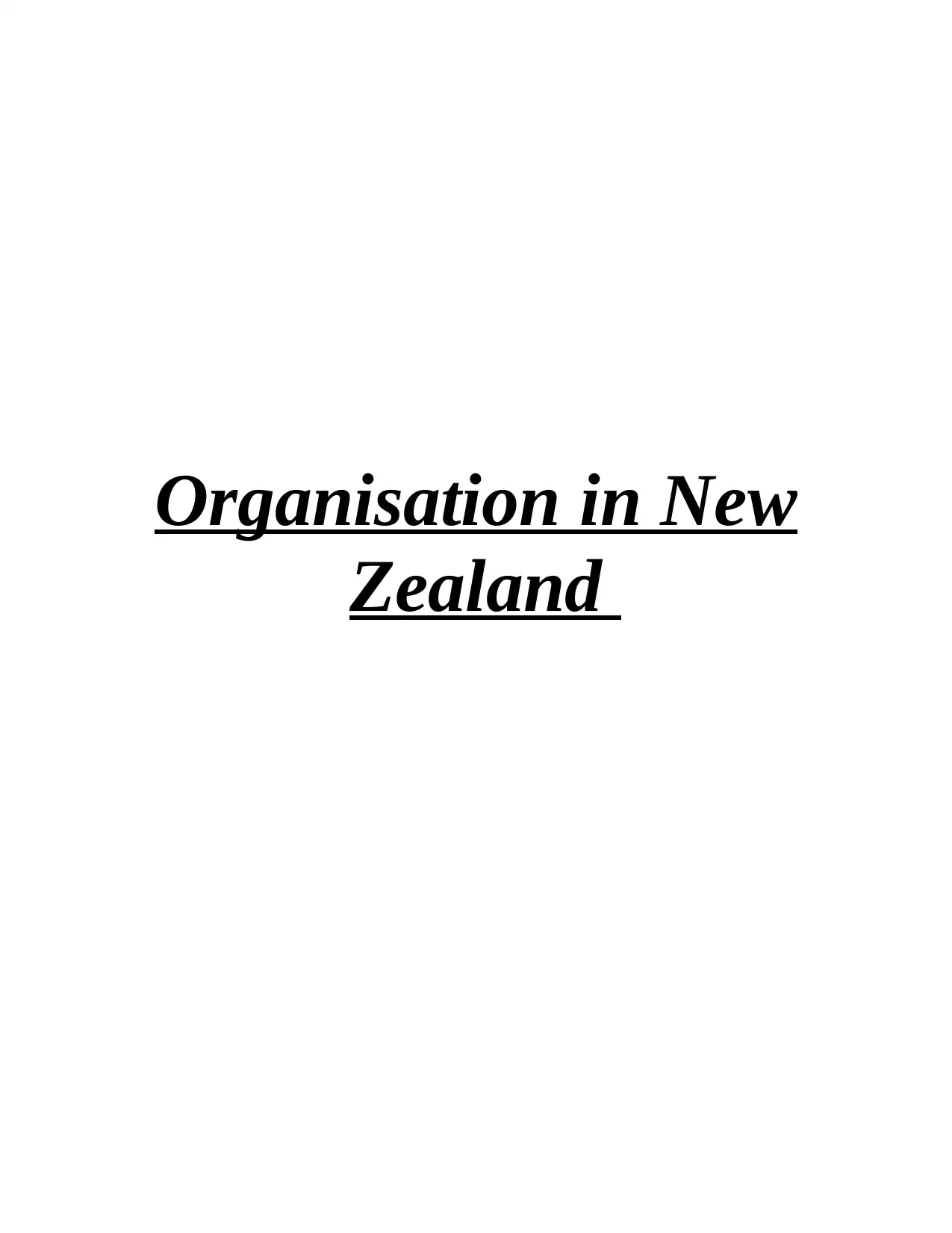
Organisation in New
Zealand
Zealand
Paraphrase This Document
Need a fresh take? Get an instant paraphrase of this document with our AI Paraphraser
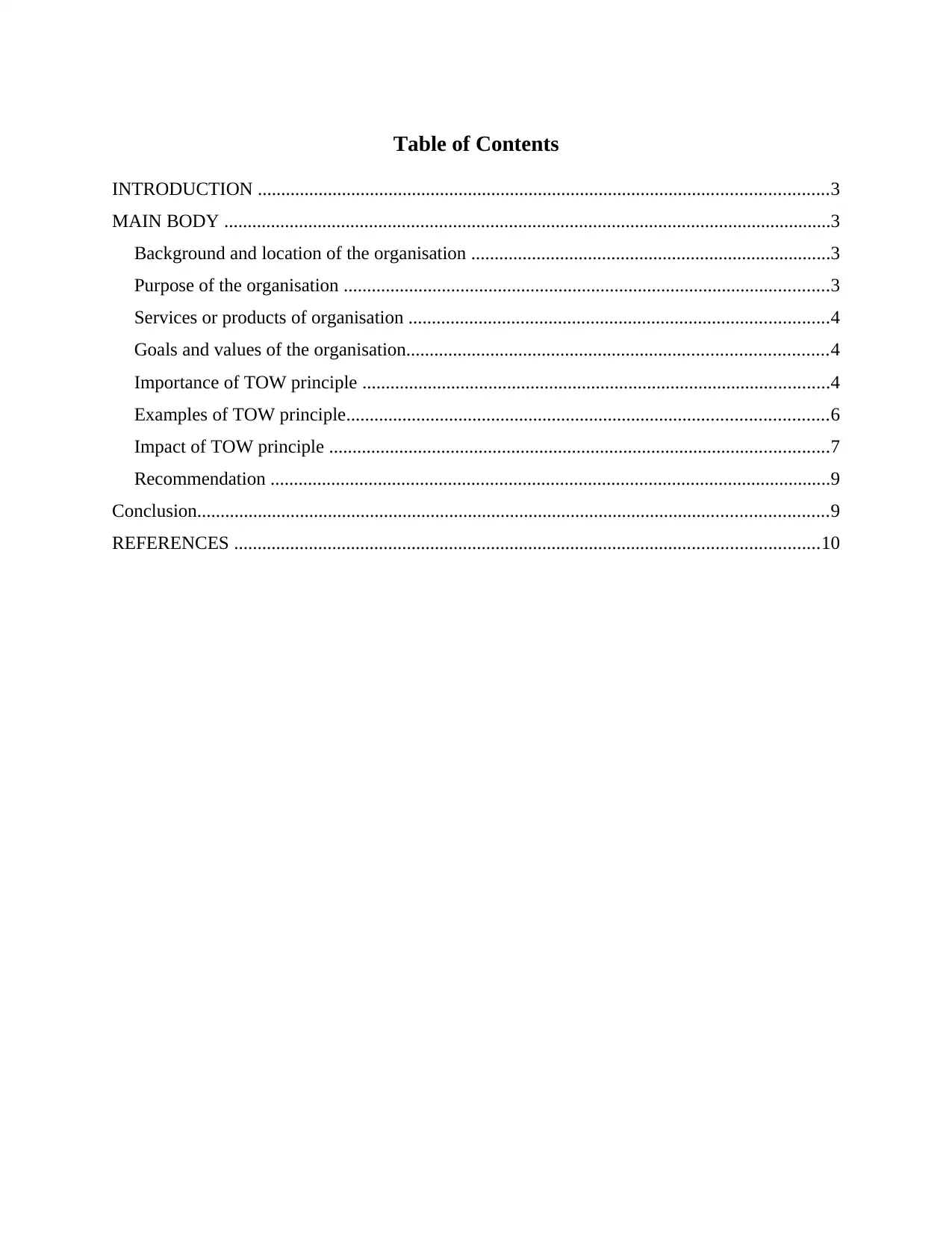
Table of Contents
INTRODUCTION ..........................................................................................................................3
MAIN BODY ..................................................................................................................................3
Background and location of the organisation .............................................................................3
Purpose of the organisation ........................................................................................................3
Services or products of organisation ..........................................................................................4
Goals and values of the organisation..........................................................................................4
Importance of TOW principle ....................................................................................................4
Examples of TOW principle.......................................................................................................6
Impact of TOW principle ...........................................................................................................7
Recommendation ........................................................................................................................9
Conclusion.......................................................................................................................................9
REFERENCES .............................................................................................................................10
INTRODUCTION ..........................................................................................................................3
MAIN BODY ..................................................................................................................................3
Background and location of the organisation .............................................................................3
Purpose of the organisation ........................................................................................................3
Services or products of organisation ..........................................................................................4
Goals and values of the organisation..........................................................................................4
Importance of TOW principle ....................................................................................................4
Examples of TOW principle.......................................................................................................6
Impact of TOW principle ...........................................................................................................7
Recommendation ........................................................................................................................9
Conclusion.......................................................................................................................................9
REFERENCES .............................................................................................................................10
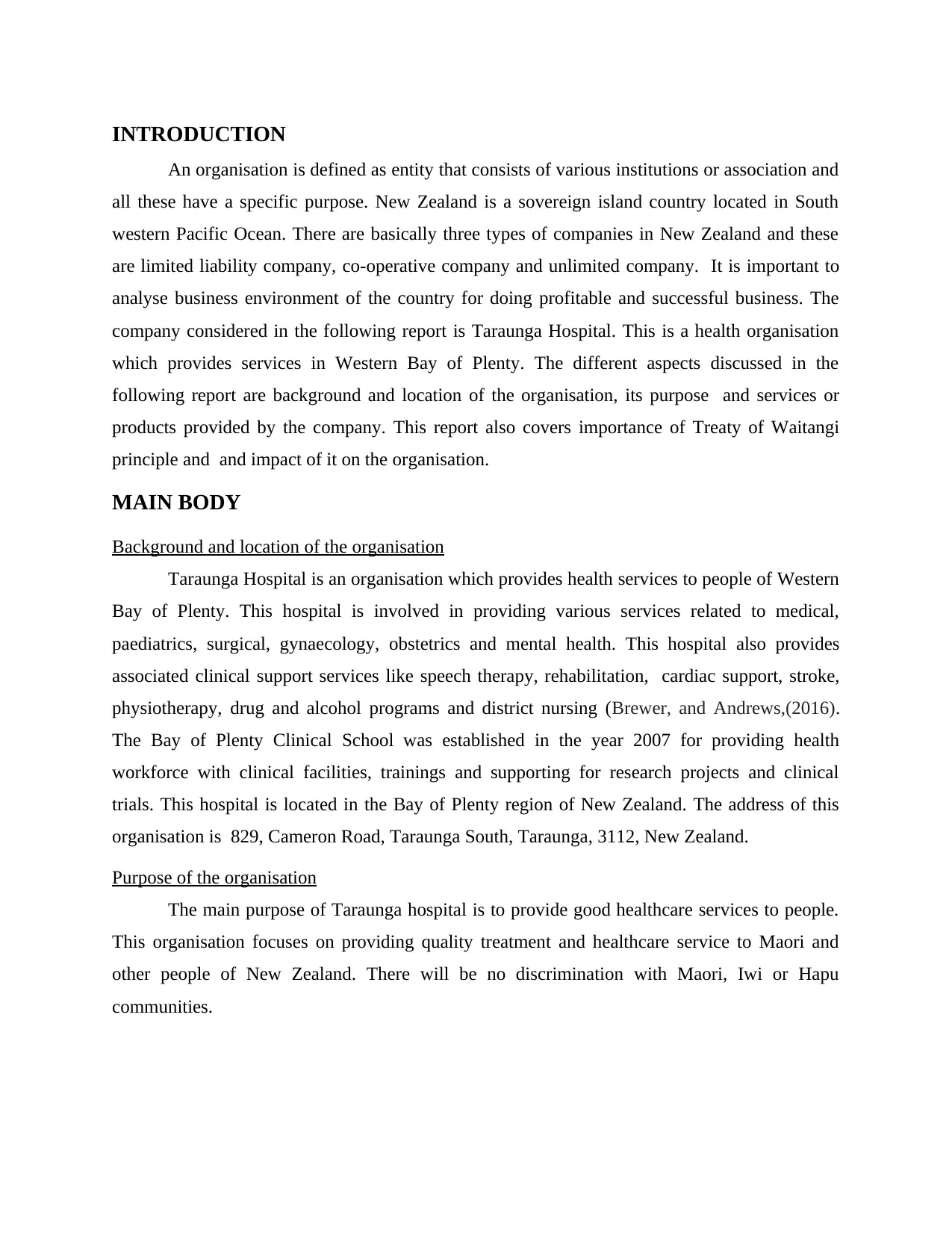
INTRODUCTION
An organisation is defined as entity that consists of various institutions or association and
all these have a specific purpose. New Zealand is a sovereign island country located in South
western Pacific Ocean. There are basically three types of companies in New Zealand and these
are limited liability company, co-operative company and unlimited company. It is important to
analyse business environment of the country for doing profitable and successful business. The
company considered in the following report is Taraunga Hospital. This is a health organisation
which provides services in Western Bay of Plenty. The different aspects discussed in the
following report are background and location of the organisation, its purpose and services or
products provided by the company. This report also covers importance of Treaty of Waitangi
principle and and impact of it on the organisation.
MAIN BODY
Background and location of the organisation
Taraunga Hospital is an organisation which provides health services to people of Western
Bay of Plenty. This hospital is involved in providing various services related to medical,
paediatrics, surgical, gynaecology, obstetrics and mental health. This hospital also provides
associated clinical support services like speech therapy, rehabilitation, cardiac support, stroke,
physiotherapy, drug and alcohol programs and district nursing (Brewer, and Andrews,(2016).
The Bay of Plenty Clinical School was established in the year 2007 for providing health
workforce with clinical facilities, trainings and supporting for research projects and clinical
trials. This hospital is located in the Bay of Plenty region of New Zealand. The address of this
organisation is 829, Cameron Road, Taraunga South, Taraunga, 3112, New Zealand.
Purpose of the organisation
The main purpose of Taraunga hospital is to provide good healthcare services to people.
This organisation focuses on providing quality treatment and healthcare service to Maori and
other people of New Zealand. There will be no discrimination with Maori, Iwi or Hapu
communities.
An organisation is defined as entity that consists of various institutions or association and
all these have a specific purpose. New Zealand is a sovereign island country located in South
western Pacific Ocean. There are basically three types of companies in New Zealand and these
are limited liability company, co-operative company and unlimited company. It is important to
analyse business environment of the country for doing profitable and successful business. The
company considered in the following report is Taraunga Hospital. This is a health organisation
which provides services in Western Bay of Plenty. The different aspects discussed in the
following report are background and location of the organisation, its purpose and services or
products provided by the company. This report also covers importance of Treaty of Waitangi
principle and and impact of it on the organisation.
MAIN BODY
Background and location of the organisation
Taraunga Hospital is an organisation which provides health services to people of Western
Bay of Plenty. This hospital is involved in providing various services related to medical,
paediatrics, surgical, gynaecology, obstetrics and mental health. This hospital also provides
associated clinical support services like speech therapy, rehabilitation, cardiac support, stroke,
physiotherapy, drug and alcohol programs and district nursing (Brewer, and Andrews,(2016).
The Bay of Plenty Clinical School was established in the year 2007 for providing health
workforce with clinical facilities, trainings and supporting for research projects and clinical
trials. This hospital is located in the Bay of Plenty region of New Zealand. The address of this
organisation is 829, Cameron Road, Taraunga South, Taraunga, 3112, New Zealand.
Purpose of the organisation
The main purpose of Taraunga hospital is to provide good healthcare services to people.
This organisation focuses on providing quality treatment and healthcare service to Maori and
other people of New Zealand. There will be no discrimination with Maori, Iwi or Hapu
communities.
⊘ This is a preview!⊘
Do you want full access?
Subscribe today to unlock all pages.

Trusted by 1+ million students worldwide
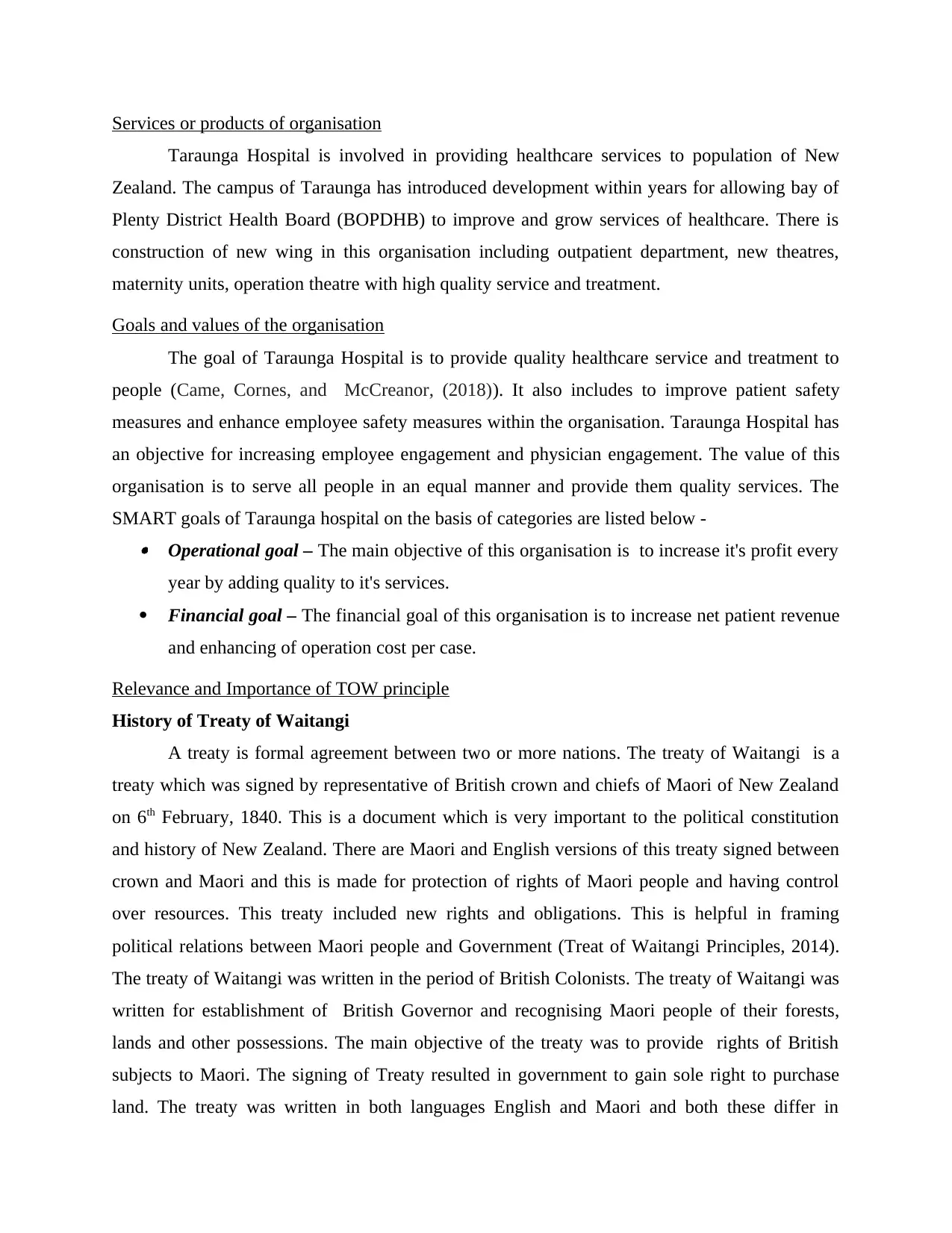
Services or products of organisation
Taraunga Hospital is involved in providing healthcare services to population of New
Zealand. The campus of Taraunga has introduced development within years for allowing bay of
Plenty District Health Board (BOPDHB) to improve and grow services of healthcare. There is
construction of new wing in this organisation including outpatient department, new theatres,
maternity units, operation theatre with high quality service and treatment.
Goals and values of the organisation
The goal of Taraunga Hospital is to provide quality healthcare service and treatment to
people (Came, Cornes, and McCreanor, (2018)). It also includes to improve patient safety
measures and enhance employee safety measures within the organisation. Taraunga Hospital has
an objective for increasing employee engagement and physician engagement. The value of this
organisation is to serve all people in an equal manner and provide them quality services. The
SMART goals of Taraunga hospital on the basis of categories are listed below - Operational goal – The main objective of this organisation is to increase it's profit every
year by adding quality to it's services.
Financial goal – The financial goal of this organisation is to increase net patient revenue
and enhancing of operation cost per case.
Relevance and Importance of TOW principle
History of Treaty of Waitangi
A treaty is formal agreement between two or more nations. The treaty of Waitangi is a
treaty which was signed by representative of British crown and chiefs of Maori of New Zealand
on 6th February, 1840. This is a document which is very important to the political constitution
and history of New Zealand. There are Maori and English versions of this treaty signed between
crown and Maori and this is made for protection of rights of Maori people and having control
over resources. This treaty included new rights and obligations. This is helpful in framing
political relations between Maori people and Government (Treat of Waitangi Principles, 2014).
The treaty of Waitangi was written in the period of British Colonists. The treaty of Waitangi was
written for establishment of British Governor and recognising Maori people of their forests,
lands and other possessions. The main objective of the treaty was to provide rights of British
subjects to Maori. The signing of Treaty resulted in government to gain sole right to purchase
land. The treaty was written in both languages English and Maori and both these differ in
Taraunga Hospital is involved in providing healthcare services to population of New
Zealand. The campus of Taraunga has introduced development within years for allowing bay of
Plenty District Health Board (BOPDHB) to improve and grow services of healthcare. There is
construction of new wing in this organisation including outpatient department, new theatres,
maternity units, operation theatre with high quality service and treatment.
Goals and values of the organisation
The goal of Taraunga Hospital is to provide quality healthcare service and treatment to
people (Came, Cornes, and McCreanor, (2018)). It also includes to improve patient safety
measures and enhance employee safety measures within the organisation. Taraunga Hospital has
an objective for increasing employee engagement and physician engagement. The value of this
organisation is to serve all people in an equal manner and provide them quality services. The
SMART goals of Taraunga hospital on the basis of categories are listed below - Operational goal – The main objective of this organisation is to increase it's profit every
year by adding quality to it's services.
Financial goal – The financial goal of this organisation is to increase net patient revenue
and enhancing of operation cost per case.
Relevance and Importance of TOW principle
History of Treaty of Waitangi
A treaty is formal agreement between two or more nations. The treaty of Waitangi is a
treaty which was signed by representative of British crown and chiefs of Maori of New Zealand
on 6th February, 1840. This is a document which is very important to the political constitution
and history of New Zealand. There are Maori and English versions of this treaty signed between
crown and Maori and this is made for protection of rights of Maori people and having control
over resources. This treaty included new rights and obligations. This is helpful in framing
political relations between Maori people and Government (Treat of Waitangi Principles, 2014).
The treaty of Waitangi was written in the period of British Colonists. The treaty of Waitangi was
written for establishment of British Governor and recognising Maori people of their forests,
lands and other possessions. The main objective of the treaty was to provide rights of British
subjects to Maori. The signing of Treaty resulted in government to gain sole right to purchase
land. The treaty was written in both languages English and Maori and both these differ in
Paraphrase This Document
Need a fresh take? Get an instant paraphrase of this document with our AI Paraphraser
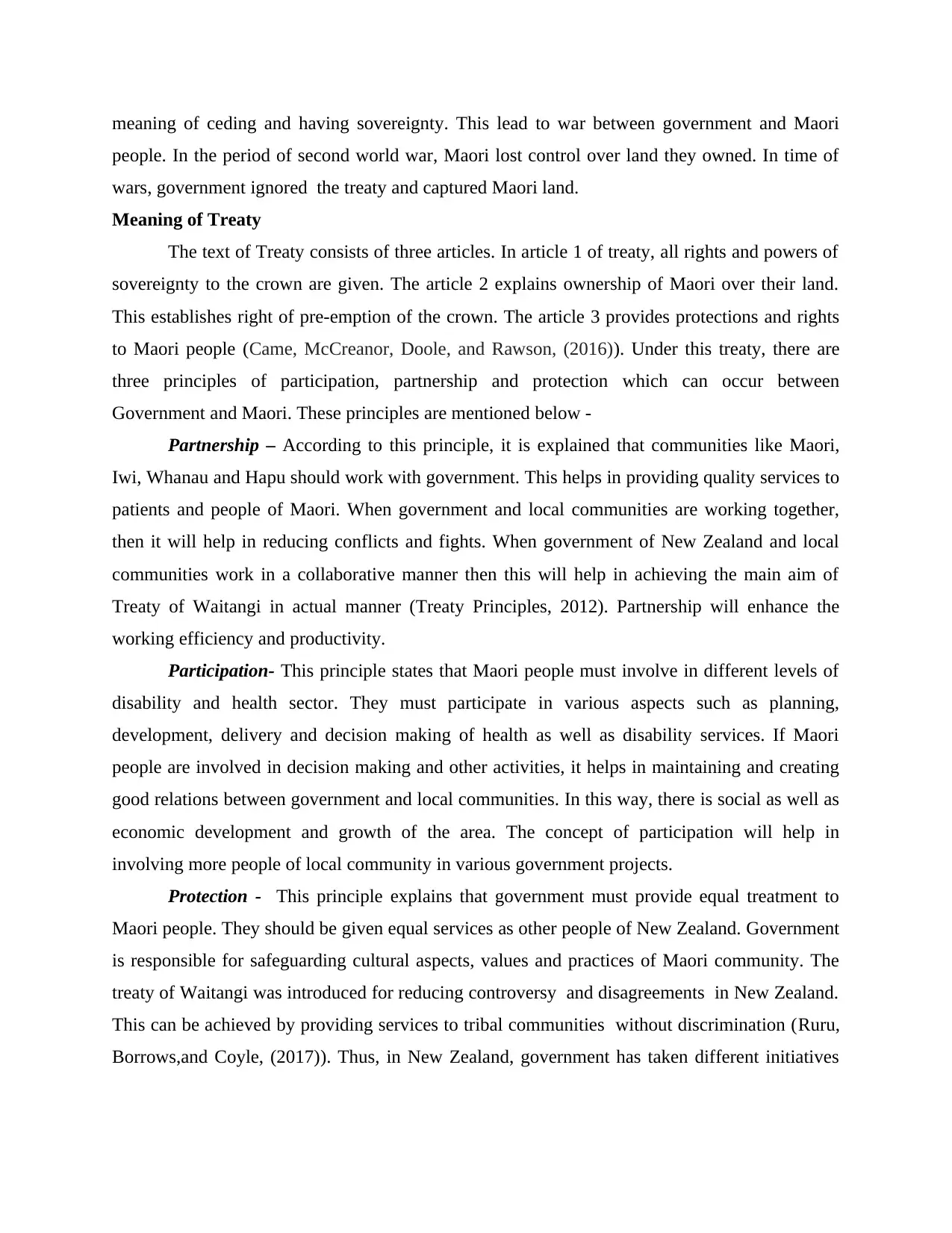
meaning of ceding and having sovereignty. This lead to war between government and Maori
people. In the period of second world war, Maori lost control over land they owned. In time of
wars, government ignored the treaty and captured Maori land.
Meaning of Treaty
The text of Treaty consists of three articles. In article 1 of treaty, all rights and powers of
sovereignty to the crown are given. The article 2 explains ownership of Maori over their land.
This establishes right of pre-emption of the crown. The article 3 provides protections and rights
to Maori people (Came, McCreanor, Doole, and Rawson, (2016)). Under this treaty, there are
three principles of participation, partnership and protection which can occur between
Government and Maori. These principles are mentioned below -
Partnership – According to this principle, it is explained that communities like Maori,
Iwi, Whanau and Hapu should work with government. This helps in providing quality services to
patients and people of Maori. When government and local communities are working together,
then it will help in reducing conflicts and fights. When government of New Zealand and local
communities work in a collaborative manner then this will help in achieving the main aim of
Treaty of Waitangi in actual manner (Treaty Principles, 2012). Partnership will enhance the
working efficiency and productivity.
Participation- This principle states that Maori people must involve in different levels of
disability and health sector. They must participate in various aspects such as planning,
development, delivery and decision making of health as well as disability services. If Maori
people are involved in decision making and other activities, it helps in maintaining and creating
good relations between government and local communities. In this way, there is social as well as
economic development and growth of the area. The concept of participation will help in
involving more people of local community in various government projects.
Protection - This principle explains that government must provide equal treatment to
Maori people. They should be given equal services as other people of New Zealand. Government
is responsible for safeguarding cultural aspects, values and practices of Maori community. The
treaty of Waitangi was introduced for reducing controversy and disagreements in New Zealand.
This can be achieved by providing services to tribal communities without discrimination (Ruru,
Borrows,and Coyle, (2017)). Thus, in New Zealand, government has taken different initiatives
people. In the period of second world war, Maori lost control over land they owned. In time of
wars, government ignored the treaty and captured Maori land.
Meaning of Treaty
The text of Treaty consists of three articles. In article 1 of treaty, all rights and powers of
sovereignty to the crown are given. The article 2 explains ownership of Maori over their land.
This establishes right of pre-emption of the crown. The article 3 provides protections and rights
to Maori people (Came, McCreanor, Doole, and Rawson, (2016)). Under this treaty, there are
three principles of participation, partnership and protection which can occur between
Government and Maori. These principles are mentioned below -
Partnership – According to this principle, it is explained that communities like Maori,
Iwi, Whanau and Hapu should work with government. This helps in providing quality services to
patients and people of Maori. When government and local communities are working together,
then it will help in reducing conflicts and fights. When government of New Zealand and local
communities work in a collaborative manner then this will help in achieving the main aim of
Treaty of Waitangi in actual manner (Treaty Principles, 2012). Partnership will enhance the
working efficiency and productivity.
Participation- This principle states that Maori people must involve in different levels of
disability and health sector. They must participate in various aspects such as planning,
development, delivery and decision making of health as well as disability services. If Maori
people are involved in decision making and other activities, it helps in maintaining and creating
good relations between government and local communities. In this way, there is social as well as
economic development and growth of the area. The concept of participation will help in
involving more people of local community in various government projects.
Protection - This principle explains that government must provide equal treatment to
Maori people. They should be given equal services as other people of New Zealand. Government
is responsible for safeguarding cultural aspects, values and practices of Maori community. The
treaty of Waitangi was introduced for reducing controversy and disagreements in New Zealand.
This can be achieved by providing services to tribal communities without discrimination (Ruru,
Borrows,and Coyle, (2017)). Thus, in New Zealand, government has taken different initiatives
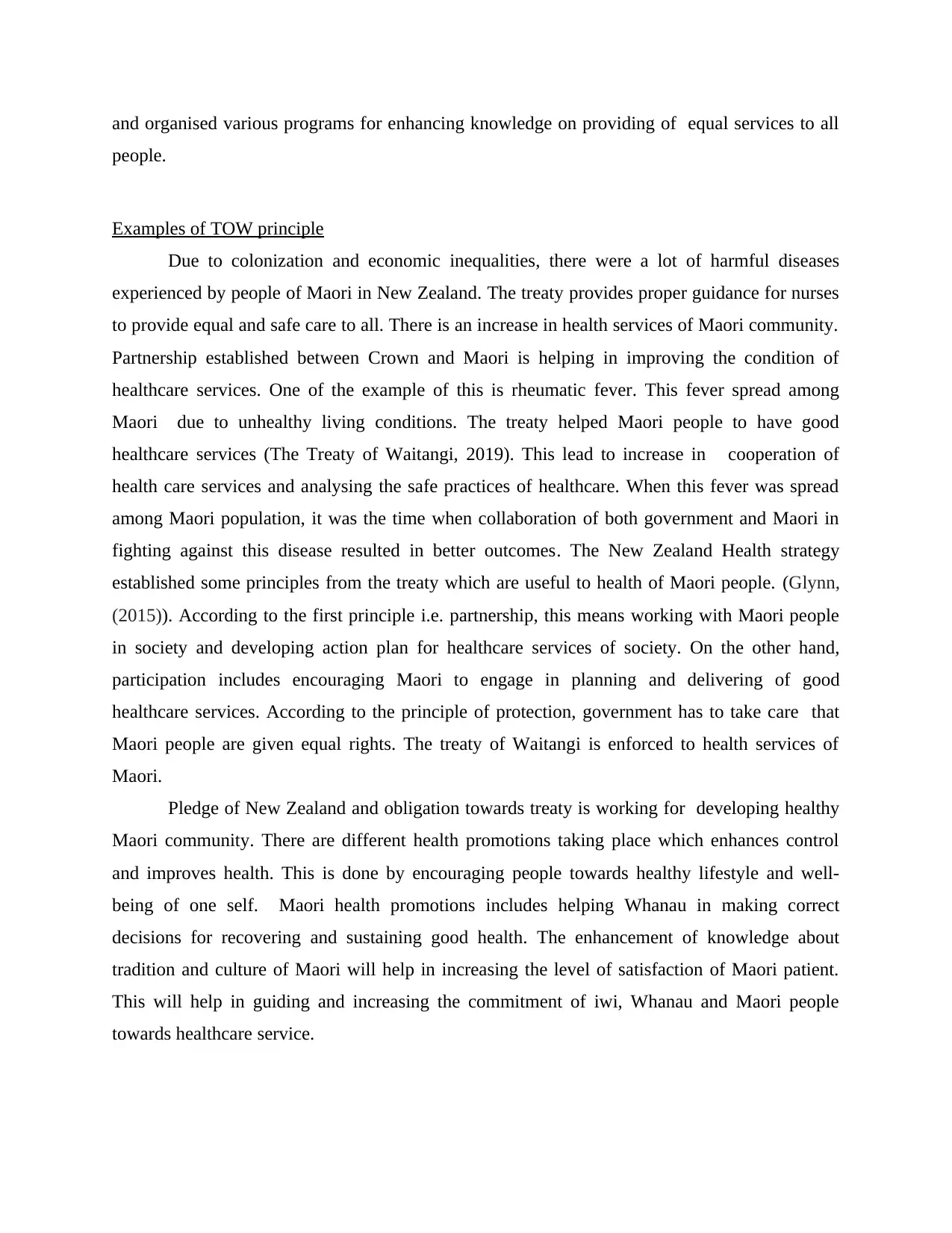
and organised various programs for enhancing knowledge on providing of equal services to all
people.
Examples of TOW principle
Due to colonization and economic inequalities, there were a lot of harmful diseases
experienced by people of Maori in New Zealand. The treaty provides proper guidance for nurses
to provide equal and safe care to all. There is an increase in health services of Maori community.
Partnership established between Crown and Maori is helping in improving the condition of
healthcare services. One of the example of this is rheumatic fever. This fever spread among
Maori due to unhealthy living conditions. The treaty helped Maori people to have good
healthcare services (The Treaty of Waitangi, 2019). This lead to increase in cooperation of
health care services and analysing the safe practices of healthcare. When this fever was spread
among Maori population, it was the time when collaboration of both government and Maori in
fighting against this disease resulted in better outcomes. The New Zealand Health strategy
established some principles from the treaty which are useful to health of Maori people. (Glynn,
(2015)). According to the first principle i.e. partnership, this means working with Maori people
in society and developing action plan for healthcare services of society. On the other hand,
participation includes encouraging Maori to engage in planning and delivering of good
healthcare services. According to the principle of protection, government has to take care that
Maori people are given equal rights. The treaty of Waitangi is enforced to health services of
Maori.
Pledge of New Zealand and obligation towards treaty is working for developing healthy
Maori community. There are different health promotions taking place which enhances control
and improves health. This is done by encouraging people towards healthy lifestyle and well-
being of one self. Maori health promotions includes helping Whanau in making correct
decisions for recovering and sustaining good health. The enhancement of knowledge about
tradition and culture of Maori will help in increasing the level of satisfaction of Maori patient.
This will help in guiding and increasing the commitment of iwi, Whanau and Maori people
towards healthcare service.
people.
Examples of TOW principle
Due to colonization and economic inequalities, there were a lot of harmful diseases
experienced by people of Maori in New Zealand. The treaty provides proper guidance for nurses
to provide equal and safe care to all. There is an increase in health services of Maori community.
Partnership established between Crown and Maori is helping in improving the condition of
healthcare services. One of the example of this is rheumatic fever. This fever spread among
Maori due to unhealthy living conditions. The treaty helped Maori people to have good
healthcare services (The Treaty of Waitangi, 2019). This lead to increase in cooperation of
health care services and analysing the safe practices of healthcare. When this fever was spread
among Maori population, it was the time when collaboration of both government and Maori in
fighting against this disease resulted in better outcomes. The New Zealand Health strategy
established some principles from the treaty which are useful to health of Maori people. (Glynn,
(2015)). According to the first principle i.e. partnership, this means working with Maori people
in society and developing action plan for healthcare services of society. On the other hand,
participation includes encouraging Maori to engage in planning and delivering of good
healthcare services. According to the principle of protection, government has to take care that
Maori people are given equal rights. The treaty of Waitangi is enforced to health services of
Maori.
Pledge of New Zealand and obligation towards treaty is working for developing healthy
Maori community. There are different health promotions taking place which enhances control
and improves health. This is done by encouraging people towards healthy lifestyle and well-
being of one self. Maori health promotions includes helping Whanau in making correct
decisions for recovering and sustaining good health. The enhancement of knowledge about
tradition and culture of Maori will help in increasing the level of satisfaction of Maori patient.
This will help in guiding and increasing the commitment of iwi, Whanau and Maori people
towards healthcare service.
⊘ This is a preview!⊘
Do you want full access?
Subscribe today to unlock all pages.

Trusted by 1+ million students worldwide
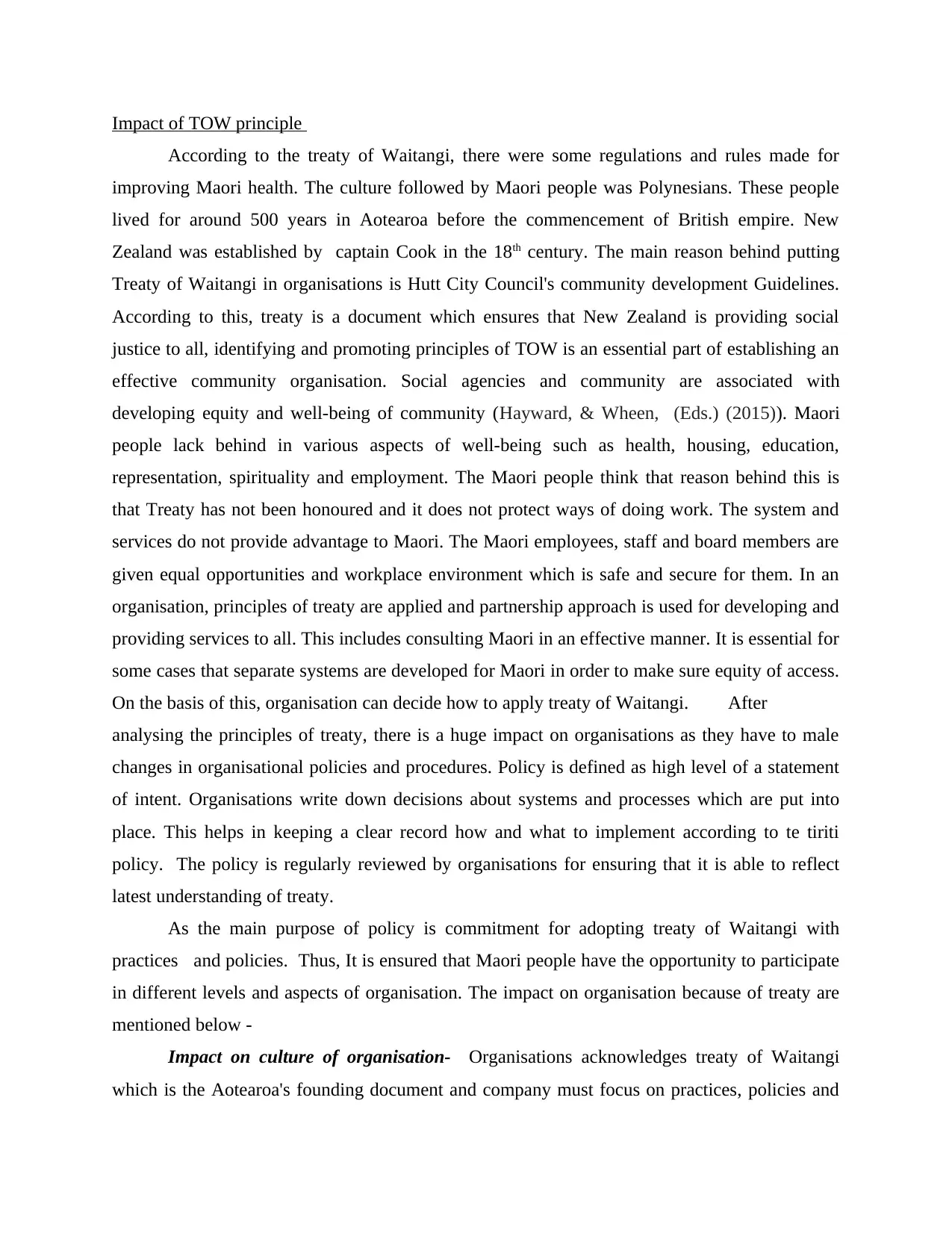
Impact of TOW principle
According to the treaty of Waitangi, there were some regulations and rules made for
improving Maori health. The culture followed by Maori people was Polynesians. These people
lived for around 500 years in Aotearoa before the commencement of British empire. New
Zealand was established by captain Cook in the 18th century. The main reason behind putting
Treaty of Waitangi in organisations is Hutt City Council's community development Guidelines.
According to this, treaty is a document which ensures that New Zealand is providing social
justice to all, identifying and promoting principles of TOW is an essential part of establishing an
effective community organisation. Social agencies and community are associated with
developing equity and well-being of community (Hayward, & Wheen, (Eds.) (2015)). Maori
people lack behind in various aspects of well-being such as health, housing, education,
representation, spirituality and employment. The Maori people think that reason behind this is
that Treaty has not been honoured and it does not protect ways of doing work. The system and
services do not provide advantage to Maori. The Maori employees, staff and board members are
given equal opportunities and workplace environment which is safe and secure for them. In an
organisation, principles of treaty are applied and partnership approach is used for developing and
providing services to all. This includes consulting Maori in an effective manner. It is essential for
some cases that separate systems are developed for Maori in order to make sure equity of access.
On the basis of this, organisation can decide how to apply treaty of Waitangi. After
analysing the principles of treaty, there is a huge impact on organisations as they have to male
changes in organisational policies and procedures. Policy is defined as high level of a statement
of intent. Organisations write down decisions about systems and processes which are put into
place. This helps in keeping a clear record how and what to implement according to te tiriti
policy. The policy is regularly reviewed by organisations for ensuring that it is able to reflect
latest understanding of treaty.
As the main purpose of policy is commitment for adopting treaty of Waitangi with
practices and policies. Thus, It is ensured that Maori people have the opportunity to participate
in different levels and aspects of organisation. The impact on organisation because of treaty are
mentioned below -
Impact on culture of organisation- Organisations acknowledges treaty of Waitangi
which is the Aotearoa's founding document and company must focus on practices, policies and
According to the treaty of Waitangi, there were some regulations and rules made for
improving Maori health. The culture followed by Maori people was Polynesians. These people
lived for around 500 years in Aotearoa before the commencement of British empire. New
Zealand was established by captain Cook in the 18th century. The main reason behind putting
Treaty of Waitangi in organisations is Hutt City Council's community development Guidelines.
According to this, treaty is a document which ensures that New Zealand is providing social
justice to all, identifying and promoting principles of TOW is an essential part of establishing an
effective community organisation. Social agencies and community are associated with
developing equity and well-being of community (Hayward, & Wheen, (Eds.) (2015)). Maori
people lack behind in various aspects of well-being such as health, housing, education,
representation, spirituality and employment. The Maori people think that reason behind this is
that Treaty has not been honoured and it does not protect ways of doing work. The system and
services do not provide advantage to Maori. The Maori employees, staff and board members are
given equal opportunities and workplace environment which is safe and secure for them. In an
organisation, principles of treaty are applied and partnership approach is used for developing and
providing services to all. This includes consulting Maori in an effective manner. It is essential for
some cases that separate systems are developed for Maori in order to make sure equity of access.
On the basis of this, organisation can decide how to apply treaty of Waitangi. After
analysing the principles of treaty, there is a huge impact on organisations as they have to male
changes in organisational policies and procedures. Policy is defined as high level of a statement
of intent. Organisations write down decisions about systems and processes which are put into
place. This helps in keeping a clear record how and what to implement according to te tiriti
policy. The policy is regularly reviewed by organisations for ensuring that it is able to reflect
latest understanding of treaty.
As the main purpose of policy is commitment for adopting treaty of Waitangi with
practices and policies. Thus, It is ensured that Maori people have the opportunity to participate
in different levels and aspects of organisation. The impact on organisation because of treaty are
mentioned below -
Impact on culture of organisation- Organisations acknowledges treaty of Waitangi
which is the Aotearoa's founding document and company must focus on practices, policies and
Paraphrase This Document
Need a fresh take? Get an instant paraphrase of this document with our AI Paraphraser
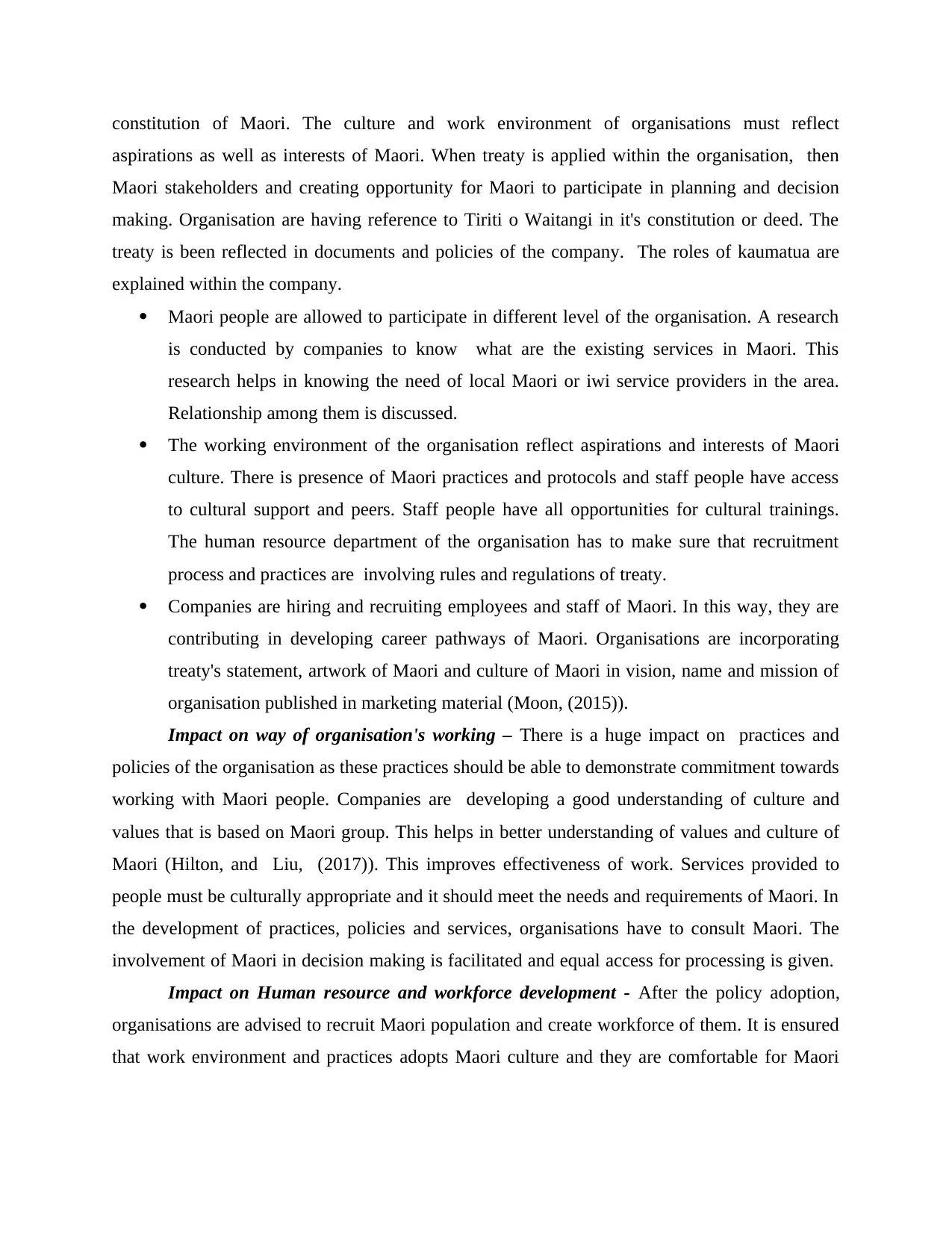
constitution of Maori. The culture and work environment of organisations must reflect
aspirations as well as interests of Maori. When treaty is applied within the organisation, then
Maori stakeholders and creating opportunity for Maori to participate in planning and decision
making. Organisation are having reference to Tiriti o Waitangi in it's constitution or deed. The
treaty is been reflected in documents and policies of the company. The roles of kaumatua are
explained within the company.
Maori people are allowed to participate in different level of the organisation. A research
is conducted by companies to know what are the existing services in Maori. This
research helps in knowing the need of local Maori or iwi service providers in the area.
Relationship among them is discussed.
The working environment of the organisation reflect aspirations and interests of Maori
culture. There is presence of Maori practices and protocols and staff people have access
to cultural support and peers. Staff people have all opportunities for cultural trainings.
The human resource department of the organisation has to make sure that recruitment
process and practices are involving rules and regulations of treaty.
Companies are hiring and recruiting employees and staff of Maori. In this way, they are
contributing in developing career pathways of Maori. Organisations are incorporating
treaty's statement, artwork of Maori and culture of Maori in vision, name and mission of
organisation published in marketing material (Moon, (2015)).
Impact on way of organisation's working – There is a huge impact on practices and
policies of the organisation as these practices should be able to demonstrate commitment towards
working with Maori people. Companies are developing a good understanding of culture and
values that is based on Maori group. This helps in better understanding of values and culture of
Maori (Hilton, and Liu, (2017)). This improves effectiveness of work. Services provided to
people must be culturally appropriate and it should meet the needs and requirements of Maori. In
the development of practices, policies and services, organisations have to consult Maori. The
involvement of Maori in decision making is facilitated and equal access for processing is given.
Impact on Human resource and workforce development - After the policy adoption,
organisations are advised to recruit Maori population and create workforce of them. It is ensured
that work environment and practices adopts Maori culture and they are comfortable for Maori
aspirations as well as interests of Maori. When treaty is applied within the organisation, then
Maori stakeholders and creating opportunity for Maori to participate in planning and decision
making. Organisation are having reference to Tiriti o Waitangi in it's constitution or deed. The
treaty is been reflected in documents and policies of the company. The roles of kaumatua are
explained within the company.
Maori people are allowed to participate in different level of the organisation. A research
is conducted by companies to know what are the existing services in Maori. This
research helps in knowing the need of local Maori or iwi service providers in the area.
Relationship among them is discussed.
The working environment of the organisation reflect aspirations and interests of Maori
culture. There is presence of Maori practices and protocols and staff people have access
to cultural support and peers. Staff people have all opportunities for cultural trainings.
The human resource department of the organisation has to make sure that recruitment
process and practices are involving rules and regulations of treaty.
Companies are hiring and recruiting employees and staff of Maori. In this way, they are
contributing in developing career pathways of Maori. Organisations are incorporating
treaty's statement, artwork of Maori and culture of Maori in vision, name and mission of
organisation published in marketing material (Moon, (2015)).
Impact on way of organisation's working – There is a huge impact on practices and
policies of the organisation as these practices should be able to demonstrate commitment towards
working with Maori people. Companies are developing a good understanding of culture and
values that is based on Maori group. This helps in better understanding of values and culture of
Maori (Hilton, and Liu, (2017)). This improves effectiveness of work. Services provided to
people must be culturally appropriate and it should meet the needs and requirements of Maori. In
the development of practices, policies and services, organisations have to consult Maori. The
involvement of Maori in decision making is facilitated and equal access for processing is given.
Impact on Human resource and workforce development - After the policy adoption,
organisations are advised to recruit Maori population and create workforce of them. It is ensured
that work environment and practices adopts Maori culture and they are comfortable for Maori
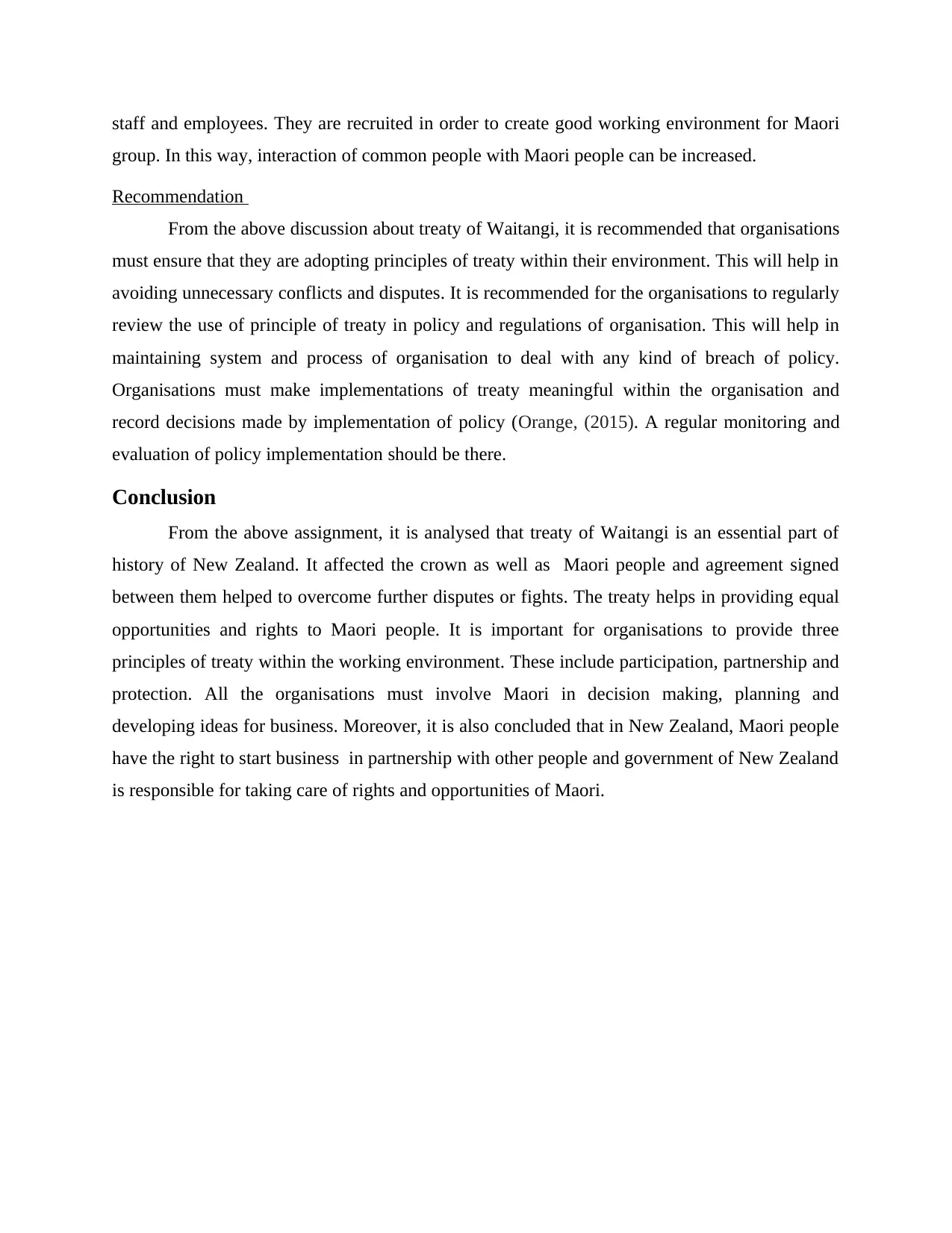
staff and employees. They are recruited in order to create good working environment for Maori
group. In this way, interaction of common people with Maori people can be increased.
Recommendation
From the above discussion about treaty of Waitangi, it is recommended that organisations
must ensure that they are adopting principles of treaty within their environment. This will help in
avoiding unnecessary conflicts and disputes. It is recommended for the organisations to regularly
review the use of principle of treaty in policy and regulations of organisation. This will help in
maintaining system and process of organisation to deal with any kind of breach of policy.
Organisations must make implementations of treaty meaningful within the organisation and
record decisions made by implementation of policy (Orange, (2015). A regular monitoring and
evaluation of policy implementation should be there.
Conclusion
From the above assignment, it is analysed that treaty of Waitangi is an essential part of
history of New Zealand. It affected the crown as well as Maori people and agreement signed
between them helped to overcome further disputes or fights. The treaty helps in providing equal
opportunities and rights to Maori people. It is important for organisations to provide three
principles of treaty within the working environment. These include participation, partnership and
protection. All the organisations must involve Maori in decision making, planning and
developing ideas for business. Moreover, it is also concluded that in New Zealand, Maori people
have the right to start business in partnership with other people and government of New Zealand
is responsible for taking care of rights and opportunities of Maori.
group. In this way, interaction of common people with Maori people can be increased.
Recommendation
From the above discussion about treaty of Waitangi, it is recommended that organisations
must ensure that they are adopting principles of treaty within their environment. This will help in
avoiding unnecessary conflicts and disputes. It is recommended for the organisations to regularly
review the use of principle of treaty in policy and regulations of organisation. This will help in
maintaining system and process of organisation to deal with any kind of breach of policy.
Organisations must make implementations of treaty meaningful within the organisation and
record decisions made by implementation of policy (Orange, (2015). A regular monitoring and
evaluation of policy implementation should be there.
Conclusion
From the above assignment, it is analysed that treaty of Waitangi is an essential part of
history of New Zealand. It affected the crown as well as Maori people and agreement signed
between them helped to overcome further disputes or fights. The treaty helps in providing equal
opportunities and rights to Maori people. It is important for organisations to provide three
principles of treaty within the working environment. These include participation, partnership and
protection. All the organisations must involve Maori in decision making, planning and
developing ideas for business. Moreover, it is also concluded that in New Zealand, Maori people
have the right to start business in partnership with other people and government of New Zealand
is responsible for taking care of rights and opportunities of Maori.
⊘ This is a preview!⊘
Do you want full access?
Subscribe today to unlock all pages.

Trusted by 1+ million students worldwide
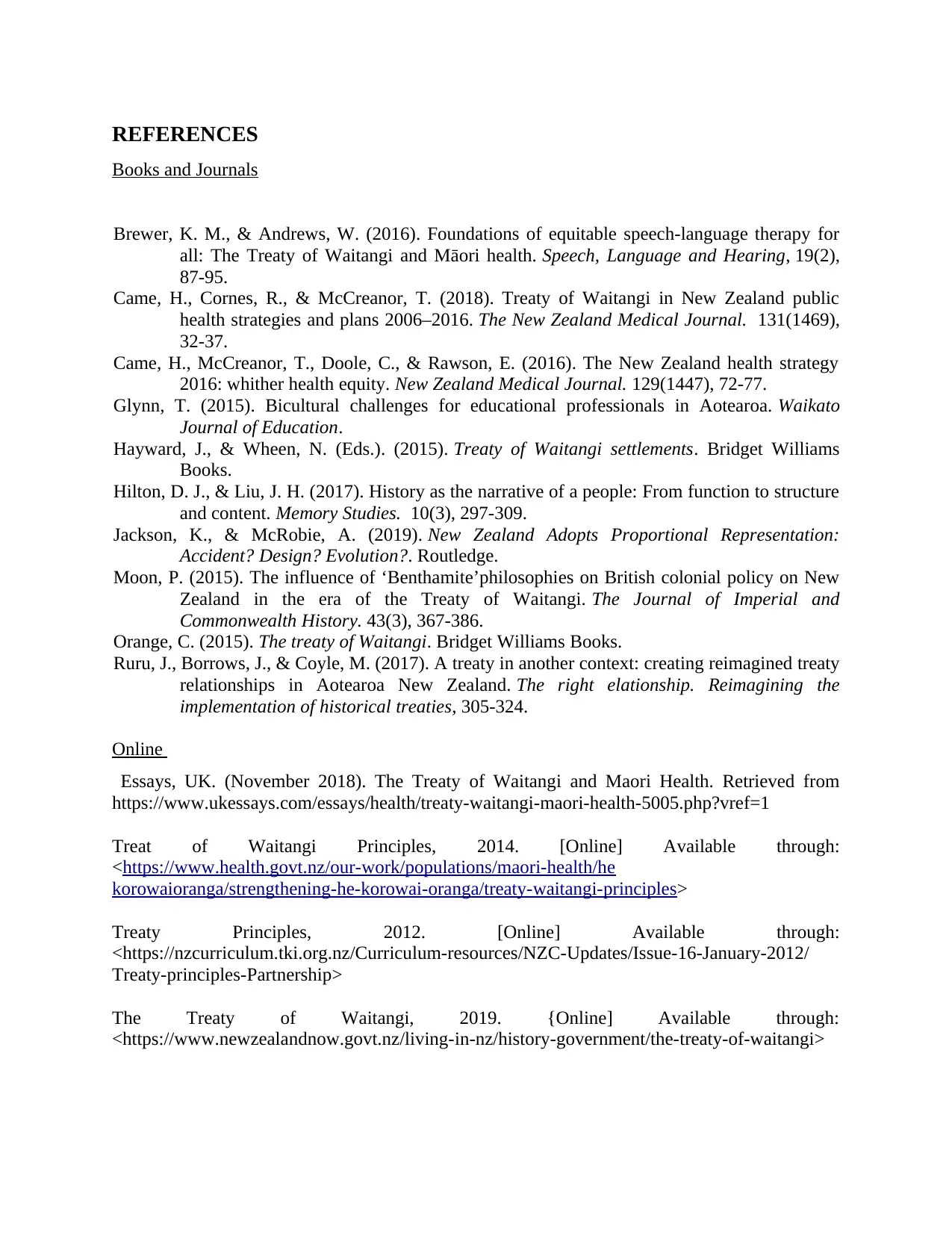
REFERENCES
Books and Journals
Brewer, K. M., & Andrews, W. (2016). Foundations of equitable speech-language therapy for
all: The Treaty of Waitangi and Māori health. Speech, Language and Hearing, 19(2),
87-95.
Came, H., Cornes, R., & McCreanor, T. (2018). Treaty of Waitangi in New Zealand public
health strategies and plans 2006–2016. The New Zealand Medical Journal. 131(1469),
32-37.
Came, H., McCreanor, T., Doole, C., & Rawson, E. (2016). The New Zealand health strategy
2016: whither health equity. New Zealand Medical Journal. 129(1447), 72-77.
Glynn, T. (2015). Bicultural challenges for educational professionals in Aotearoa. Waikato
Journal of Education.
Hayward, J., & Wheen, N. (Eds.). (2015). Treaty of Waitangi settlements. Bridget Williams
Books.
Hilton, D. J., & Liu, J. H. (2017). History as the narrative of a people: From function to structure
and content. Memory Studies. 10(3), 297-309.
Jackson, K., & McRobie, A. (2019). New Zealand Adopts Proportional Representation:
Accident? Design? Evolution?. Routledge.
Moon, P. (2015). The influence of ‘Benthamite’philosophies on British colonial policy on New
Zealand in the era of the Treaty of Waitangi. The Journal of Imperial and
Commonwealth History. 43(3), 367-386.
Orange, C. (2015). The treaty of Waitangi. Bridget Williams Books.
Ruru, J., Borrows, J., & Coyle, M. (2017). A treaty in another context: creating reimagined treaty
relationships in Aotearoa New Zealand. The right elationship. Reimagining the
implementation of historical treaties, 305-324.
Online
Essays, UK. (November 2018). The Treaty of Waitangi and Maori Health. Retrieved from
https://www.ukessays.com/essays/health/treaty-waitangi-maori-health-5005.php?vref=1
Treat of Waitangi Principles, 2014. [Online] Available through:
<https://www.health.govt.nz/our-work/populations/maori-health/he
korowaioranga/strengthening-he-korowai-oranga/treaty-waitangi-principles>
Treaty Principles, 2012. [Online] Available through:
<https://nzcurriculum.tki.org.nz/Curriculum-resources/NZC-Updates/Issue-16-January-2012/
Treaty-principles-Partnership>
The Treaty of Waitangi, 2019. {Online] Available through:
<https://www.newzealandnow.govt.nz/living-in-nz/history-government/the-treaty-of-waitangi>
Books and Journals
Brewer, K. M., & Andrews, W. (2016). Foundations of equitable speech-language therapy for
all: The Treaty of Waitangi and Māori health. Speech, Language and Hearing, 19(2),
87-95.
Came, H., Cornes, R., & McCreanor, T. (2018). Treaty of Waitangi in New Zealand public
health strategies and plans 2006–2016. The New Zealand Medical Journal. 131(1469),
32-37.
Came, H., McCreanor, T., Doole, C., & Rawson, E. (2016). The New Zealand health strategy
2016: whither health equity. New Zealand Medical Journal. 129(1447), 72-77.
Glynn, T. (2015). Bicultural challenges for educational professionals in Aotearoa. Waikato
Journal of Education.
Hayward, J., & Wheen, N. (Eds.). (2015). Treaty of Waitangi settlements. Bridget Williams
Books.
Hilton, D. J., & Liu, J. H. (2017). History as the narrative of a people: From function to structure
and content. Memory Studies. 10(3), 297-309.
Jackson, K., & McRobie, A. (2019). New Zealand Adopts Proportional Representation:
Accident? Design? Evolution?. Routledge.
Moon, P. (2015). The influence of ‘Benthamite’philosophies on British colonial policy on New
Zealand in the era of the Treaty of Waitangi. The Journal of Imperial and
Commonwealth History. 43(3), 367-386.
Orange, C. (2015). The treaty of Waitangi. Bridget Williams Books.
Ruru, J., Borrows, J., & Coyle, M. (2017). A treaty in another context: creating reimagined treaty
relationships in Aotearoa New Zealand. The right elationship. Reimagining the
implementation of historical treaties, 305-324.
Online
Essays, UK. (November 2018). The Treaty of Waitangi and Maori Health. Retrieved from
https://www.ukessays.com/essays/health/treaty-waitangi-maori-health-5005.php?vref=1
Treat of Waitangi Principles, 2014. [Online] Available through:
<https://www.health.govt.nz/our-work/populations/maori-health/he
korowaioranga/strengthening-he-korowai-oranga/treaty-waitangi-principles>
Treaty Principles, 2012. [Online] Available through:
<https://nzcurriculum.tki.org.nz/Curriculum-resources/NZC-Updates/Issue-16-January-2012/
Treaty-principles-Partnership>
The Treaty of Waitangi, 2019. {Online] Available through:
<https://www.newzealandnow.govt.nz/living-in-nz/history-government/the-treaty-of-waitangi>
1 out of 10
Related Documents
Your All-in-One AI-Powered Toolkit for Academic Success.
+13062052269
info@desklib.com
Available 24*7 on WhatsApp / Email
![[object Object]](/_next/static/media/star-bottom.7253800d.svg)
Unlock your academic potential
Copyright © 2020–2025 A2Z Services. All Rights Reserved. Developed and managed by ZUCOL.





